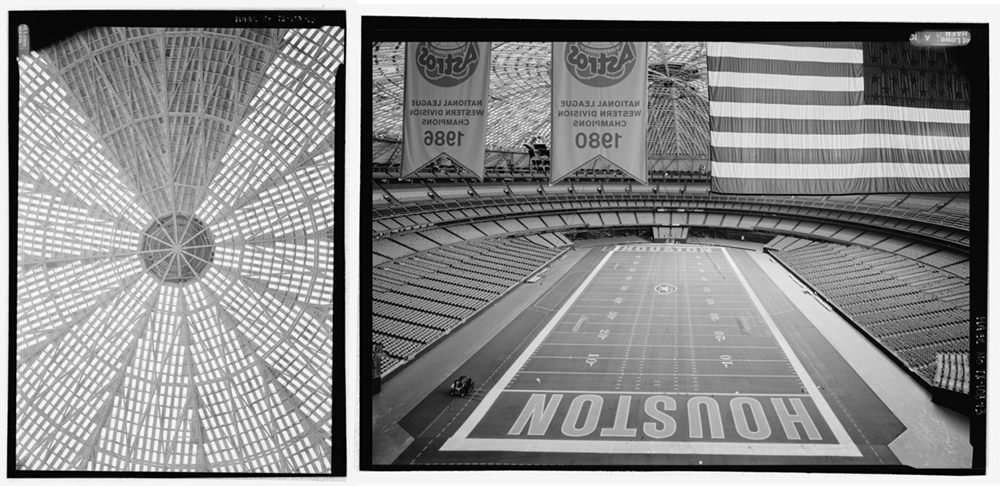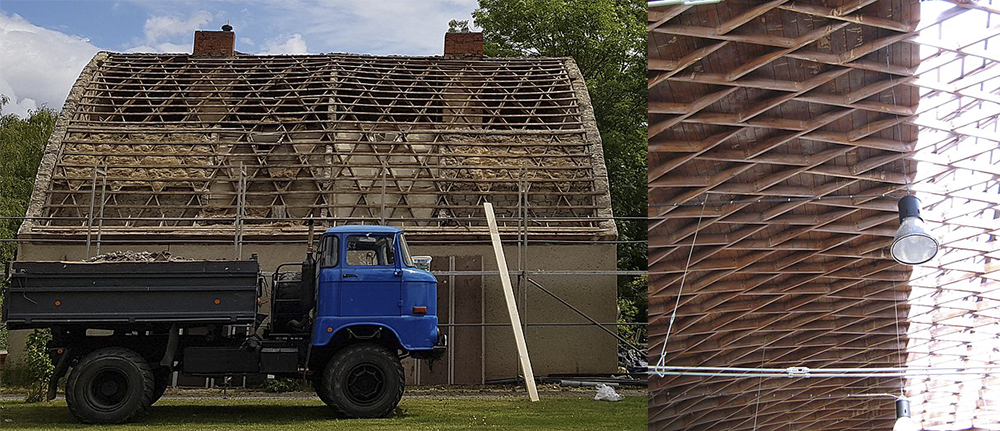Lamella structure
Contents |
[edit] Introduction
A lamella or lamellar structure is normally made up of a series of smaller component parts, often of the same material and one that could potentially be a lamella board but also timber or steel. A lamella structure may also be referred to as a reciprocal grid because the individual members reciprocate support to neighbouring members in a grid form, thus acting as a whole in unison, they are similar to and may be referred to as gridshells, geodesic domes or reciprocal roofs and reciprocal grids as well as Zollinger roofs. See also Lamella Board.
[edit] Components
In most cases reciprocal lamella structures will be made up of elements which are twice the length of each grid unit, so that the next member is supported at the midpoint of the previous. This type of structure allows each member to be made up of relatively thin two dimensional linear beams or plates, in more complex structures these might be cut into certain shapes that interlink or slot together creating three dimensional structures or gridshells. A technique that expanded in popularity with the availability of CNC cutters or 2D routing in the 1970's and 80's.
[edit] Examples
There are many different examples of what might be referred to a lamella structures globally, one of the largest is perhaps the Houston Astrodome, which was the world's first multi-purpose, domed sports stadium, located in Houston, Texas, US, Although now closed it had a record attendance of 67,925 set by the World Wrestling Federation in 2001. The structure is often referred to as being a lamella dome, because it has a diamond shaped pattern on the underside of the spherical surface. It is a domed circular concrete and steel framed building, constructed of steel pieces joined and welded together form a complex domed grid in tension. The dome structure is 220m in diameter, with a ceiling 63 m above the playing surface stands and covering 9.5 acres or 3.8 hectares.
An earlier and well known example of a timber lamella roofing system is called the Zollinger roof, after the German architect, city planner and municipal construction official, Friedrich Zollinger who developed the system. Although relatively labour intensive to construct by skilled workers, the design had a number of advantages including the absence of long tie beams or supporting posts, significantly less material required than traditional roofs, it could adapt to openings and could be made entirely of short pieces of timber which could be prefabricated and installed without large machinery. s such the roofing systems was adopted at times when materials and costs were prohibitive, such as between the World Wars. Historical examples of Zollinger roofs can be found in a house in Schweicheln-Bermbeck and Augustinus church in Heilbronn, Germany, whilst modern examples can be found throughout Europe.
[edit] Related articles on Designing Buildings
- Braced frame.
- Bridge construction.
- Balloon framing.
- Concrete frame.
- Domestic roofs.
- Gridshell.
- Gusset.
- Hammerbeam roof.
- Lamella board.
- Long span roof.
- Pitched roof.
- Portal frame.
- Purlins.
- Sheathing.
- Space frame.
- Structural steelwork.
- Skeleton frame.
- Steel frame.
- Strut.
- Ties.
- Timber engineered structural frames.
- Timber gridshell.
- Timber roof.
- Timber framed buildings and fire.
- Timber post and beam construction.
- Timber preservation.
- Types of frame.
- Types of timber.
- Types of roof.
- Types of structural load.
Featured articles and news
The UK’s largest air pollution campaign.
Future Homes Standard, now includes solar, but what else?
Will the new standard, due to in the Autumn, go far enough in terms of performance ?
BSRIA Briefing: Cleaner Air, Better tomorrow
A look back at issues relating to inside and outside air quality, discussed during the BSRIA briefing in 2023.
Restoring Abbotsford's hothouse
Bringing the writer Walter Scott's garden to life.
Reflections on the spending review with CIAT.
Retired firefighter cycles world to raise Grenfell funds
Leaving on 14 June 2025 Stephen will raise money for youth and schools through the Grenfell Foundation.
Key points for construction at a glance with industry reactions.
Functionality, visibility and sustainability
The simpler approach to specification.
Architects, architecture, buildings, and inspiration in film
The close ties between makers and the movies, with our long list of suggested viewing.
SELECT three-point plan for action issued to MSPs
Call for Scottish regulation, green skills and recognition of electrotechnical industry as part of a manifesto for Scottish Parliamentary elections.
UCEM becomes the University of the Built Environment
Major milestone in its 106-year history, follows recent merger with London School of Architecture (LSE).
Professional practical experience for Architects in training
The long process to transform the nature of education and professional practical experience in the Architecture profession following recent reports.
A people-first approach to retrofit
Moving away from the destructive paradigm of fabric-first.
International Electrician Day, 10 June 2025
Celebrating the role of electrical engineers from André-Marie Amperè, today and for the future.
New guide for clients launched at Houses of Parliament
'There has never been a more important time for clients to step up and ...ask the right questions'
The impact of recycled slate tiles
Innovation across the decades.
EPC changes for existing buildings
Changes and their context as the new RdSAP methodology comes into use from 15 June.

























